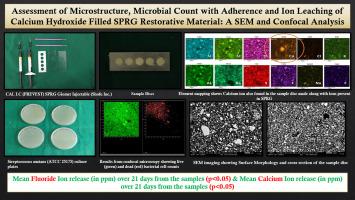评价氢氧化钙填充SPRG修复材料的微观结构、粘附微生物数量和离子浸出:扫描电镜和共聚焦分析
IF 2.3
4区 医学
Q3 ENGINEERING, BIOMEDICAL
引用次数: 0
摘要
目的研究氢氧化钙填充的表面预反应玻璃离聚体(SPRG)修复材料的表征。分析的重点是材料的微观结构和抗菌性能,特别是它对变形链球菌(一种常见的口腔细菌)的功效。使用扫描电子显微镜(SEM)和共聚焦显微镜,我们检查材料的表面形态,微生物粘附和离子浸出能力。目的是评估该材料在深度龋病治疗中的适用性及其作为牙本质替代物的潜力。方法与材料制备氢氧化钙填充SPRG修复材料盘(10 mm × 2 mm)。利用扫描电子显微镜观察材料的表面形貌和显微组织特征。为了评估微生物粘附性和计数,用共聚焦显微镜观察在材料上培养的变形链球菌。采用离子选择电极(ISE)法对钙、氟离子的浸出进行了定量分析。结果钙、氟离子明显浸出,表明该材料具有离子释放潜能。扫描电镜分析提供了SPRG修复材料微观结构的详细信息,而共聚焦显微镜显示了活的和死的变形链球菌菌落之间的明显区别,这表明氟化物和钙离子浸出有助于有效的抗菌性能。结论氢氧化钙填充的SPRG修复材料具有离子释放和有效的抗菌性能,是治疗深部龋和替代牙本质的有力候选材料,具有广阔的应用前景。正在进行的研究可以优化这些材料的临床应用,推进牙科修复。本文章由计算机程序翻译,如有差异,请以英文原文为准。

Assessment of microstructure, microbial count with adherence and ion leaching of calcium hydroxide filled SPRG restorative material: A SEM and confocal analysis
Aim
This study investigates the characterization of a calcium hydroxide-filled SPRG (Surface Pre-Reacted Glass Ionomer) restorative material. The analysis focuses on the material's microstructure and antimicrobial properties, specifically its efficacy against Streptococcus mutans, a common oral bacterium. Using Scanning Electron Microscopy (SEM) and confocal microscopy, we examine the material's surface morphology, microbial adherence, and ion leaching capabilities. The goal is to assess the material’s suitability for deep caries management and its potential as a dentine replacement.
Methods and Materials
Discs of Calcium Hydroxide filled SPRG Restorative Material were prepared (10 mm x 2 mm). SEM was employed to observe the surface morphology and microstructural characteristics of the material. To evaluate microbial adherence and count, confocal microscopy was used with Streptococcus mutans cultured on the material. The leaching of calcium and fluoride ions was quantified using the Ion Selective Electrode (ISE) method.
Results
The results showed significant leaching of calcium and fluoride ions, indicating the material's potential for ion release. SEM analysis provided detailed insights into the microstructure of the SPRG restorative material, while confocal microscopy revealed a clear distinction between live and dead Streptococcus mutans colonies, suggesting that the fluoride and calcium ion leaching contributed to effective antimicrobial properties.
Conclusion
Calcium hydroxide-filled SPRG restorative materials show promise for dental applications, with ion release and effective antimicrobial properties making them strong candidates for managing deep caries and potentially replacing dentine. Ongoing research could optimize these materials for clinical use, advancing restorative dentistry.
求助全文
通过发布文献求助,成功后即可免费获取论文全文。
去求助
来源期刊

Medical Engineering & Physics
工程技术-工程:生物医学
CiteScore
4.30
自引率
4.50%
发文量
172
审稿时长
3.0 months
期刊介绍:
Medical Engineering & Physics provides a forum for the publication of the latest developments in biomedical engineering, and reflects the essential multidisciplinary nature of the subject. The journal publishes in-depth critical reviews, scientific papers and technical notes. Our focus encompasses the application of the basic principles of physics and engineering to the development of medical devices and technology, with the ultimate aim of producing improvements in the quality of health care.Topics covered include biomechanics, biomaterials, mechanobiology, rehabilitation engineering, biomedical signal processing and medical device development. Medical Engineering & Physics aims to keep both engineers and clinicians abreast of the latest applications of technology to health care.
 求助内容:
求助内容: 应助结果提醒方式:
应助结果提醒方式:


